Rhubarb is an herbaceous perennial plant in the family Polygonaceae, typically grown for its tart flavor and edible stalks. In some parts of the world, especially in North America, it is referred to as a vegetable rather than a fruit. It has large, vibrant leaves and long reddish-green stalks used in pies, crisps, jams, compotes, and other recipes. Although rhubarb is most famously associated with desserts and sweet applications, it can also be used to make savory dishes such as chutneys and pickles featuring its unique tangy flavor.
What is Rhubarb?
Rhubarb is a plant native to areas of Europe and Asia, where it has been cultivated for centuries. In the United States, rhubarb was first introduced in the 1800s and quickly gained popularity due to its tart flavor. Today, it’s widely available fresh in supermarkets and farmers’ markets throughout North America. The stalks of the plant are typically eaten cooked as they are too tough and stringy to be consumed raw.
History and Origin of Rhubarb:
Rhubarb’s earliest recorded use dates back to 2700 BC in China, where it was used medicinally and as a food source. It was grown extensively in Chinese and Tibetan gardens and spread westward through the Silk Road. By the 17th century, it had arrived in Europe; by the 19th century, rhubarb production had occurred on an industrial scale across England. Today, rhubarb is cultivated worldwide, and its popularity continues to grow due to its health benefits (which will be discussed later).
Types of Rhubarb:
There are two main types of rhubarb: red and green. Red rhubarb is the most widely known variety and has a vibrant pinkish-red color. It has a deep tart flavor with a hint of sweetness, making it ideal for baking pies, crisps, compotes, and jams. Green rhubarb is less common but tastes similar to red rhubarb but with a slightly milder flavor.
Cultivation of Rhubarb:
Rhubarb requires a cool climate with moist soil for optimal growth. In temperate climates like the United States, it is best planted between mid-October and early December to take advantage of the winter chill for optimal growth in spring/summer. When planting, you should dig compost or manure into the soil to improve drainage and water retention. It is important to note that rhubarb crowns should be planted 7-12 inches deep and 12-18 inches apart to have sufficient room for their roots.
Nutrition of Rhubarb:
Rhubarb is an excellent source of dietary fiber, vitamin K and calcium, as well as a good source of potassium, magnesium, and vitamin C. Its antioxidant content has been reported to be significant; it contains quercetin (5.5mg/100g), cyanidin (2.4mg/100g) and kaempferol (1.7 mg/100g). Rhubarb is low in calories but high in vitamins, minerals, and phytochemicals, making it a very healthy food.
Health Benefits of Rhubarb:
Rhubarb contains numerous plant compounds that have been reported to provide health benefits such as improved digestion, anti-inflammatory properties, and protection against certain forms of cancer. It is also believed to help reduce high blood pressure and cholesterol levels. Additionally, rhubarb consumption has been shown to improve bone mineral density and reduce the risks of osteoporosis in postmenopausal women.
Cooking with Rhubarb:
Rhubarb can be enjoyed cooked or raw. When adding it to recipes, you will want to make sure you only use the stalks (not the leaves), as they are the edible parts of the plant. The versatility of rhubarb makes it a great ingredient to use in sweet and savory dishes. Sweet applications include pies, crisps, muffins, and compotes, while savory recipes can range from chutneys and pickles to soups and stews.
Rhubarb has been grown worldwide for centuries due to its unique tart flavor and numerous health benefits. Its versatility makes it a great addition to sweet and savory recipes, so why not give rhubarb a try today? Your taste buds (and your body) will thank you!
How to Plant Rhubarb?
Rhubarb is a hardy perennial vegetable that can be enjoyed in many different ways. It has a tart, tangy flavor and is often used in pies, jams, jellies, and other desserts. Rhubarb is also becoming more popular in savory dishes like stir-fries and salads. Planting rhubarb is easy and can give you years of harvests with the proper care.
Preparing Your Site:
The site you choose to plant your rhubarb should have full sun exposure for at least six hours daily. Prepare the soil by removing weeds or grasses, digging it up, and mixing organic matter such as compost. The ideal pH level for rhubarb is 6.0 to 7.0; if your soil is too acidic, amend it with lime or other alkaline materials.
Planting Rhubarb:
When planting rhubarb, choose a variety that does well in your area and buy several crowns from a reputable nursery or garden center. Plant them during the early spring when the soil can be worked. Make sure to space the plants at least 2 feet apart and dig the holes slightly larger than the roots, so they have plenty of room to spread out. Cover each plant with enough soil, so only the crown’s very top is visible.
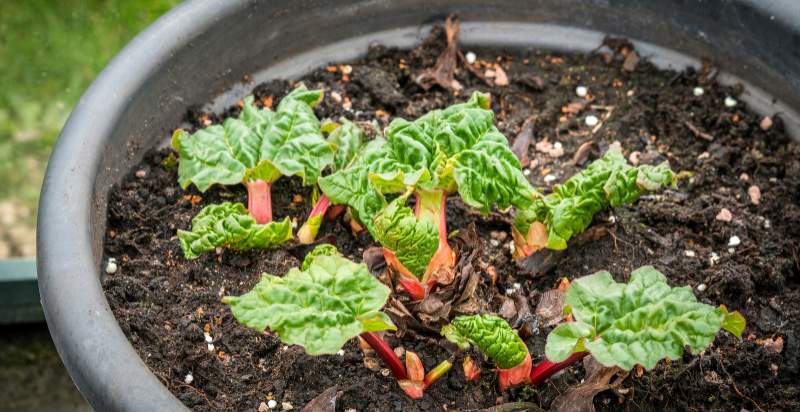
Watering and Fertilizing:
Rhubarb plants must be watered regularly during the warmer months, especially during dry spells. Keep the soil moist but not soggy; too much moisture can cause diseases or fungus. Fertilize your rhubarb plants about once every month with a balanced slow-release fertilizer for best results.
Dividing & Harvesting:
It’s important to leave at least three years between divisions of mature rhubarb plants, as dividing them too often will weaken their vigor and reduce harvest yields. When it is time to divide, carefully dig up the clump of rhubarb roots, separate individual crowns, and replant in fresh soil. You can begin harvesting your rhubarb after the plant has been established for a few years.
Harvest the stalks by gently twisting them off near their base; avoid pulling or yanking on the stems, as this can damage the plant. To ensure a continuous supply of rhubarb, pick only a few stalks at a time and leave some to keep growing.
Once established, rhubarb requires very little maintenance. Keep the area free of weeds and debris, water regularly during dry spells, and fertilize about once every month. In the early spring, mulch around the plants to help retain moisture and prevent weeds from growing. In late fall, cut back any brown or dead leaves to make the plant look tidy for winter.
With proper care, rhubarb will last for many years in your garden. Enjoy!
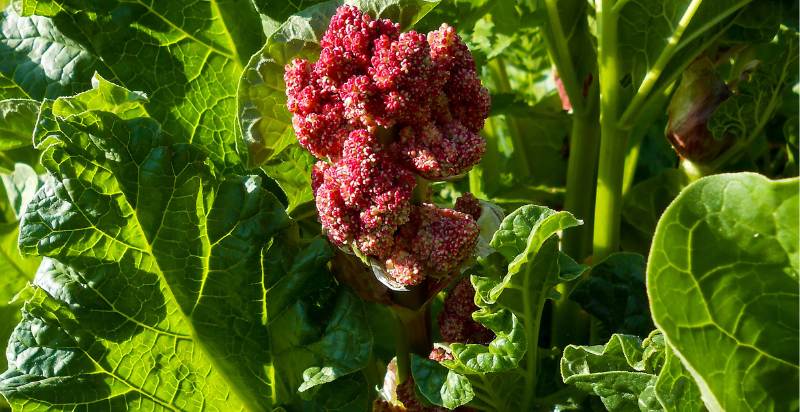
How to Care for and Grow Rhubarb?
- Plant rhubarb in a sunny location, but keep it out of direct sunlight. Rhubarb prefers temperatures between 45 and 75 degrees Fahrenheit (7 to 24 Celsius).
- Provide adequate water during the growing season, usually from April to October. Water deeply every 7-10 days or as needed.
- Spread a layer of organic mulch around the plant in early spring to help retain soil moisture and suppress weeds.
- Fertilize rhubarb with a balanced fertilizer such as 10-10-10 once per month during the growing season. Alternatively, use a slow-release fertilizer applied three times per year in late winter/early spring, mid-summer, and late fall.
- Cut off flower stalks as soon as they appear to allow the plant to focus its energy on leaf growth rather than flowering.
- Do not harvest rhubarb during the first year of planting so that it has time to establish a strong root system. In subsequent years, harvest sparingly in early summer until plants mature and produce thick stems.
- Divide and replant rhubarb every 4-5 years or when the clump becomes overcrowded and unproductive.
- Watch for signs of disease, such as wilting leaves, discolored foliage, and rotted crowns, which can indicate fungal diseases such as anthracnose and crown rot. Treat with fungicides if necessary.
- Remove dead leaves from the plant and discard them in the garbage to prevent disease spread.
- Prune rhubarb back in late fall or early winter to remove old, dead stalks and open up the center of the plant for better air circulation and fewer pests and diseases.
- Cover the plant with a layer of straw mulch over winter to protect it from extremely cold temperatures.
- Keep an eye out for pests such as aphids, mites, and slugs, which can cause damage to the leaves. Treat infestations with insecticidal soap or other organic methods as soon as possible to prevent further damage.
- Harvest rhubarb stalks with a sharp knife or scissors when they reach 8-10 inches (20-25 cm) long. Take only what you need and leave the rest so the plant can thrive.
- Rinse harvested rhubarb under cold running water and use it within a few days of harvesting for the best flavor and texture. Rhubarb stores well in the refrigerator for up to two weeks.
Enjoy your homegrown rhubarb in pies, jams, sauces, and other recipes! Good luck with your rhubarb gardening.
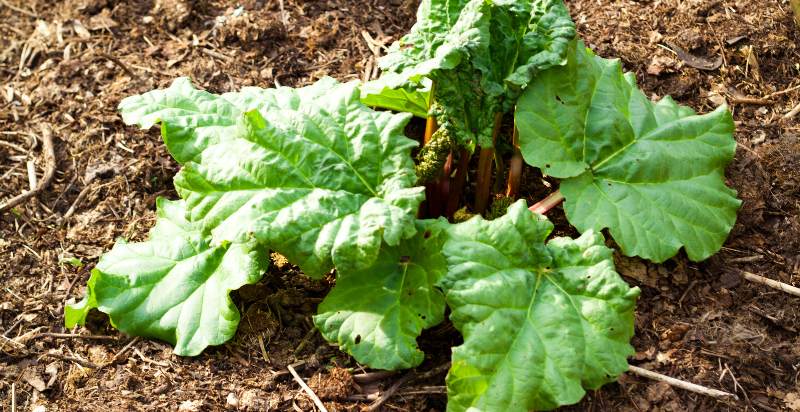
Preventions from Pests and Diseases:
- Choose a planting site with well-draining soil and plenty of suns, as rhubarb is susceptible to root rot in wet conditions.
- Plant resistant varieties when possible to reduce your chances of pest or disease problems.
- Avoid overhead watering whenever possible since the leaves can remain wet for long periods and promote the growth of fungi and bacteria.
- Keep weeds under control around the plants to reduce humidity and decrease the chance of disease.
- Prune dead leaves, stalks, and any damaged tissue on your rhubarb plants regularly to keep them healthy and prevent fungal infections.
- Inspect your plants regularly for signs of pests and diseases and take action immediately if any problems are found.
- 7Apply a fungicidal spray to the plants in early spring and mid-summer as an additional preventative measure against fungal infections.
- Keep all gardening tools clean and sharp to reduce the spread of disease.
- Rotate your rhubarb crop every two years to a new location in the garden and discard any diseased plants immediately.
- Avoid planting other crops, such as tomatoes, potatoes, or peppers, close to your rhubarb, since these can increase the chances of disease transfer.
Follow these simple tips to keep your rhubarb plants healthy and productive for many years.
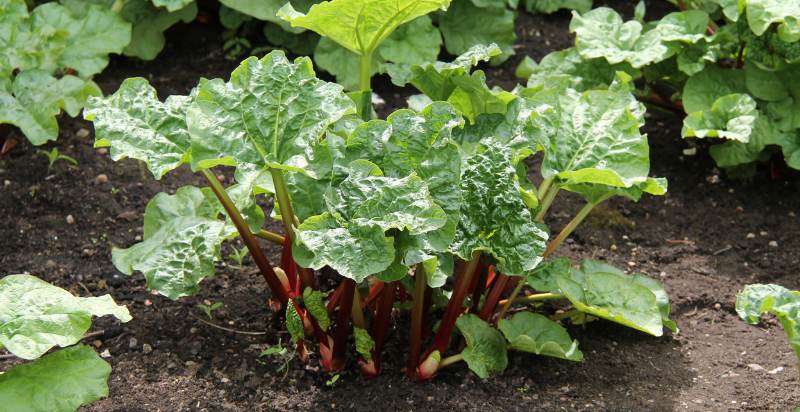
How to Harvest Rhubarb Plant?
- Harvest rhubarb stalks when they are 8-10 inches (20-25 cm) long and still firm.
- Cut the stalk down at the base, using a sharp knife or scissors, to ensure it is completely removed from the plant.
- Discard any yellowed, wilted, or damaged stalks immediately.
- Don’t take more than a third of the plant at one time to ensure it can continue growing and remain productive.
- Rinse harvested rhubarb under cold running water and use it within a few days for the best flavor and texture. Rhubarb stores well in the refrigerator for up to two weeks.
Harvesting rhubarb is easy once you know what to look for! Enjoy your homegrown rhubarb in pies, jams, sauces, and other recipes! Good luck with your rhubarb gardening!
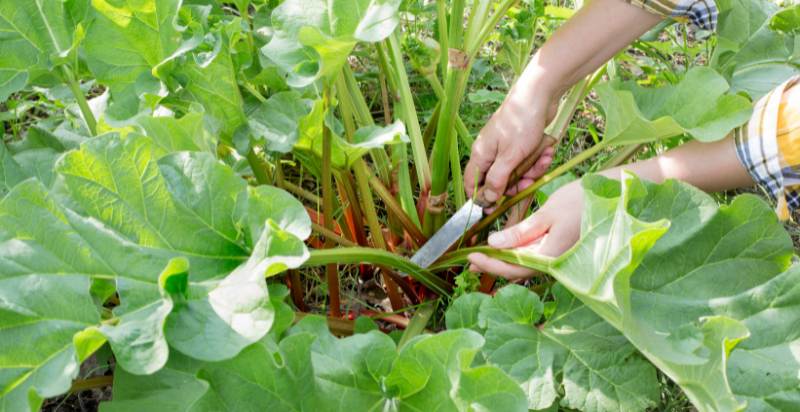
How to Store Homegrown Rhubarb ?
- Rinse harvested rhubarb under cold running water and pat dry with a paper towel or dishcloth.
- Trim off any discolored or damaged parts before storing your rhubarb.
- Place the stalks in an airtight container or bag and store them in the refrigerator for up to two weeks for the best flavor and texture.
- Rhubarb can be frozen for longer-term storage, either as whole stalks or cut into slices. To freeze, rinse, trim and cut the stalks into 1/2 inch (1 cm) slices, spread them on a baking sheet, and freeze until solid before transferring them to a sealed container or zip-top bag.
Store your homegrown rhubarb correctly and enjoy its delicious flavor all year round.
How to Use Rhubarb?
- Enjoy homegrown rhubarb in pies, jams, sauces, and other recipes such as muffins, crumbles, tarts, and cobblers
- Use rhubarb to make a simple syrup for cocktails or mocktails
- Add chopped rhubarb to smoothies for a tangy flavor
- Roast with vegetables for an interesting side dish
- Make a compote with honey, cinnamon, and orange zest
- Blend into sorbets and ice creams
Rhubarb is easy to grow at home and can be used in many different ways! Its tart taste and bright color make it the perfect addition to sweet or savory dishes. Enjoy experimenting with this versatile plant!
With these tips and recipes, you’ll grow and enjoy homegrown rhubarb in no time! Have fun in the garden and happy harvesting.
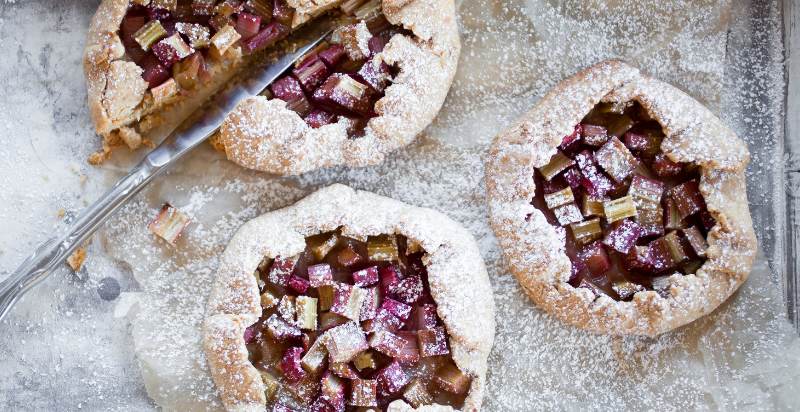
Potential Risks From Rhubarb:
- Rhubarb leaves contain oxalic acid and are poisonous if eaten, so make sure to remove them before using the stalks in recipes
- Eating large amounts of rhubarb can cause stomach upset, nausea, vomiting, and diarrhea
- While most people tolerate freshly harvested rhubarb without any issues, some may experience an allergic reaction due to sensitivity to its oxalic acid content
- Uncooked rhubarb should not be fed to animals as it is toxic for them
With these safety tips in mind, enjoy growing and harvesting your homegrown rhubarb and all the delicious dishes you can prepare! Have a safe and enjoyable time in the garden.
Conclusion:
Growing rhubarb at home is a rewarding experience, with delicious stalks to harvest and enjoy in many recipes. With careful attention to soil health and the right harvesting techniques, you can ensure your rhubarb plants remain productive for years to come. Make sure to take all the necessary safety precautions while handling raw rhubarb and any potential risks associated with eating it. Have fun in the garden and enjoy all the tasty dishes you can create with homegrown rhubarb!
- Everything You Wanted to Know About Red Tamarillos - June 2, 2025
- A Guide to Tulips: Everything You Need to Know & More… - June 2, 2025
- Guanabana: Description, Flavor, Benefits, And Uses - May 27, 2025

2 thoughts on “What is Rhubarb? How to Plant, Grow, and Harvest Rhubarb”
Comments are closed.